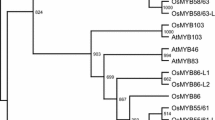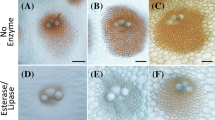Abstract
Key message
Sugar regulation of gene expression has profound effects at all stages of the plant life cycle. Although regulation at the transcriptional level is one of the most prominent mechanisms by which gene expression is regulated, only a few transcription factors have been identified and demonstrated to be involved in the regulation of sugar-regulated gene expression. OsMYBS1, an R1/2-type MYB transcription factor, has been demonstrated to be involved in sugar- and hormone-regulated α-amylase gene expression in rice. Arabidopsis contains two OsMYBS1 homologs. In the present study, we investigate MYBS1 and MYBS2 in sugar signaling in Arabidopsis. Our results indicate that MYBS1 and MYBS2 play opposite roles in regulating glucose and ABA signaling in Arabidopsis during seed germination and early seedling development.
Abstract
MYB proteins have been classified into four subfamilies: R2R3-MYB, R1/2-MYB, 3R-MYB, and 4R-MYB. An R1/2-type MYB transcription factor, OsMYBS1, has been demonstrated to be involved in sugar- and hormone-regulated α-amylase genes expression in rice. In this study, two genes homologous to OsMYBS1, MYBS1 and MYBS2, were investigated in Arabidopsis. Subcellular localization analysis showed that MYBS1 and MYBS2 were localized in the nucleus. Rice embryo transient expression assays indicated that both MYBS1 and MYBS2 could recognize the sugar response element, TA-box, in the promoter and induced promoter activity. mybs1 mutant exhibited hypersensitivity to glucose, whereas mybs2 seedlings were hyposensitive to it. MYBS1 and MYBS2 are involved in the control of glucose-responsive gene expression, as the mybs1 mutant displayed increased expression of a hexokinase gene (HXK1), chlorophyll a/b-binding protein gene (CAB1), ADP-glucose pyrophosphorylase gene (APL3), and chalcone synthase gene (CHS), whereas the mybs2 mutant exhibited decreased expression of these genes. mybs1 also showed an enhanced response to abscisic acid (ABA) in the seed germination and seedling growth stages, while mybs2 showed reduced responses. The ABA biosynthesis inhibitor fluridone rescued the mybs1 glucose-hypersensitive phenotype. Moreover, the mRNA levels of three ABA biosynthesis genes, ABA1, NCED9, and AAO3, and three ABA signaling genes, ABI3, ABI4, and ABI5, were increased upon glucose treatment of mybs1 seedlings, but were decreased in mybs2 seedlings. These results indicate that MYBS1 and MYBS2 play opposite roles in regulating glucose and ABA signaling in Arabidopsis during seed germination and early seedling development.









Similar content being viewed by others
References
Arenas-Huertero F, Arroyo A, Zhou L, Sheen J, Leon P (2000) Analysis of Arabidopsis glucose insensitive mutants, gin5 and gin6, reveals a central role of the plant hormone ABA in the regulation of plant vegetative development by sugar. Genes Dev 14:2085–2096
Baena-Gonzalez E (2010) Energy signaling in the regulation of gene expression during stress. Mol Plant 3:300–313
Baena-Gonzalez E, Rolland F, Thevelein JM, Sheen J (2007) A central integrator of transcription networks in plant stress and energy signalling. Nature 448:938–942
Carvalho RF, Carvalho SD, Duque P (2010) The plant-specific SR45 protein negatively regulates glucose and ABA signaling during early seedling development in Arabidopsis. Plant Physiol 154:772–783
Chan MT, Yu SM (1998a) The 3’ untranslated region of a rice alpha-amylase gene functions as a sugar-dependent mRNA stability determinant. Proc Natl Acad Sci USA 95:6543–6547
Chan MT, Yu SM (1998b) The 3’ untranslated region of a rice alpha-amylase gene mediates sugar-dependent abundance of mRNA. Plant J 15:685–695
Chen PW, Lu CA, Yu TS, Tseng TH, Wang CS, Yu SM (2002) Rice alpha-amylase transcriptional enhancers direct multiple mode regulation of promoters in transgenic rice. J Biol Chem 277:13641–13649
Cheng WH, Endo A, Zhou L, Penney J, Chen HC, Arroyo A, Leon P, Nambara E, Asami T, Seo M, Koshiba T, Sheen J (2002) A unique short-chain dehydrogenase/reductase in Arabidopsis glucose signaling and abscisic acid biosynthesis and functions. Plant Cell 14:2723–2743
Ciereszkoa I, Kleczkowskib LA (2002) Glucose and mannose regulate the expression of a major sucrose synthase gene in Arabidopsis via hexokinase-dependent mechanisms. Plant Physiol Biochem 40:907–911
Clough SJ, Bent AF (1998) Floral dip: a simplified method for Agrobacterium-mediated transformation of Arabidopsis thaliana. Plant J 16:735–743
Curtis MD, Grossniklaus U (2003) A gateway cloning vector set for high-throughput functional analysis of genes in planta. Plant Physiol 133:462–469
Eveland AL, Jackson DP (2012) Sugars, signalling, and plant development. J Exp Bot 63:3367–3377
Finkelstein RR, Lynch TJ (2000) Abscisic acid inhibition of radicle emergence but not seedling growth is suppressed by sugars. Plant Physiol 122:1179–1186
Gibson SI, Laby RJ, Kim D (2001) The sugar-insensitive1 (sis1) mutant of Arabidopsis is allelic to ctr1. Biochem Biophys Res Commun 280:196–203
Huang CK, Lo PC, Huang LF, Wu SJ, Yeh CH, Lu CA (2015) A single-repeat MYB transcription repressor, MYBH, participates in regulation of leaf senescence in Arabidopsis. Plant Mol Biol 88:269–286
Huijser C, Kortstee A, Pego J, Weisbeek P, Wisman E, Smeekens S (2000) The Arabidopsis SUCROSE UNCOUPLED-6 gene is identical to ABSCISIC ACID INSENSITIVE-4: involvement of abscisic acid in sugar responses. Plant J 23:577–585
Jang JC, Sheen J (1994) Sugar sensing in higher plants. Plant Cell 6:1665–1679
Kang SG, Price J, Lin PC, Hong JC, Jang JC (2010) The Arabidopsis bZIP1 transcription factor is involved in sugar signaling, protein networking, and DNA binding. Mol Plant 3:361–373
Koch K (2004) Sucrose metabolism: regulatory mechanisms and pivotal roles in sugar sensing and plant development. Curr Opin Plant Biol 7:235–246
Koch KE, Wu Y, Xu J (1996) Sugar and metabolic regulation of genes for sucrose metabolism: potential influence of maize sucrose synthase and soluble invertase responses on carbon partitioning and sugar sensing. J Exp Bot 47:1179–1185
Laby RJ, Kincaid MS, Kim D, Gibson SI (2000) The Arabidopsis sugar-insensitive mutants sis4 and sis5 are defective in abscisic acid synthesis and response. Plant J 23:587–596
Lu CA, Lim EK, Yu SM (1998) Sugar response sequence in the promoter of a rice alpha-amylase gene serves as a transcriptional enhancer. J Biol Chem 273:10120–10131
Lu CA, Ho TH, Ho SL, Yu SM (2002) Three novel MYB proteins with one DNA binding repeat mediate sugar and hormone regulation of alpha-amylase gene expression. Plant Cell 14:1963–1980
Lu CA, Lin CC, Lee KW, Chen JL, Huang LF, Ho SL, Liu HJ, Hsing YI, Yu SM (2007) The SnRK1A protein kinase plays a key role in sugar signaling during germination and seedling growth of rice. Plant Cell 19:2484–2499
Mita S, Suzuki-Fujii K, Nakamura K (1995) Sugar-inducible expression of a gene for beta-amylase in Arabidopsis thaliana. Plant Physiol 107:895–904
Moore B, Zhou L, Rolland F, Hall Q, Cheng WH, Liu YX, Hwang I, Jones T, Sheen J (2003) Role of the Arabidopsis glucose sensor HXK1 in nutrient, light, and hormonal signaling. Science 300:332–336
Muller R, Morant M, Jarmer H, Nilsson L, Nielsen TH (2007) Genome-wide analysis of the Arabidopsis leaf transcriptome reveals interaction of phosphate and sugar metabolism. Plant Physiol 143:156–171
Price J, Laxmi A, St Martin SK, Jang JC (2004) Global transcription profiling reveals multiple sugar signal transduction mechanisms in Arabidopsis. Plant Cell 16:2128–2150
Rolland F, Sheen J (2005) Sugar sensing and signaling networks in plants. Biochem Soc Trans 33:269–271
Rolland F, Moore B, Sheen J. (2002) Sugar sensing and signaling in plants. Plant Cell 14(Suppl 1):S185–S205
Rolland F, Baena-Gonzalez E, Sheen J (2006) Sugar sensing and signaling in plants: conserved and novel mechanisms. Annu Rev Plant Biol 57:675–709
Rook F, Corke F, Card R, Munz G, Smith C, Bevan MW (2001) Impaired sucrose-induction mutants reveal the modulation of sugar-induced starch biosynthetic gene expression by abscisic acid signaling. Plant J 26:421–433
Rook F, Hadingham SA, Li Y, Bevan MW (2006) Sugar and ABA response pathways and the control of gene expression. Plant Cell Environ 29:426–434
Rubio-Somoza I, Martinez M, Diaz I, Carbonero P (2006) HvMCB1, a R1MYB transcription factor from barley with antagonistic regulatory functions during seed development and germination. Plant J 45:17–30
Sheen J (2014) Master regulators in plant glucose signaling networks. J Plant Biol 57:67–79
Sheu JJ, Jan SP, Lee HT, Yu SM (1994) Control of transcription and messenger-RNA turnover as mechanisms of metabolic repression of alpha-amylase gene-expression. Plant J 5:655–664
Sun C, Palmqvist S, Olsson H, Boren M, Ahlandsberg S, Jansson C (2003) A novel WRKY transcription factor, SUSIBA2, participates in sugar signaling in barley by binding to the sugar-responsive elements of the iso1 promoter. Plant Cell 15:2076–2092
Xiao W, Sheen J, Jang JC (2000) The role of hexokinase in plant sugar signal transduction and growth and development. Plant Mol Biol 44:451–461
Xiong Y, Sheen J (2013) Moving beyond translation: glucose-TOR signaling in the transcriptional control of cell cycle. Cell Cycle 12:1989–1990
Yanhui C, Xiaoyuan Y, Kun H, Meihua L, Jigang L, Zhaofeng G, Zhiqiang L, Yunfei Z, Xiaoxiao W, Xiaoming Q, Yunping S, Li Z, Xiaohui D, Jingchu L, Xing-Wang D, Zhangliang C, Hongya G, Li-Jia Q (2006) The MYB transcription factor superfamily of Arabidopsis: expression analysis and phylogenetic comparison with the rice MYB family. Plant Mol Biol 60:107–124
Yuan K, Wysocka-Diller J (2006) Phytohormone signalling pathways interact with sugars during seed germination and seedling development. J Exp Bot 57:3359–3367
Zhang X, Ju HW, Chung MS, Huang P, Ahn SJ, Kim CS (2011) The R-R-Type MYB-like transcription factor, AtMYBL, is involved in promoting leaf senescence and modulates an abiotic stress response in Arabidopsis. Plant Cell Physiol 52:138–148
Zhou L, Jang JC, Jones TL, Sheen J (1998) Glucose and ethylene signal transduction crosstalk revealed by an Arabidopsis glucose-insensitive mutant. Proc Natl Acad Sci U S A 95:10294–10299
Acknowledgements
This work was supported by grants (104-2321-B-008-001 and 105-2321-B-008-001) from the Ministry of Science and Technology of the Republic of China, Taiwan.
Authors’ contributions
YC, YC, and CL participated in the design of the study. YC, YC, and TT carried out the gene cloning, real-time RT-PCR, and subcellular localization. PL and CH carried out the GUS activity assay. TT, and CH carried out the bioinformatics analysis. YC, and CL carried out data analysis, and wrote manuscript. All authors read and approved the final manuscript.
Author information
Authors and Affiliations
Corresponding author
Additional information
Yi-Shih Chen and Yi-Chi Chao have contributed equally to this work.
Electronic supplementary material
Below is the link to the electronic supplementary material.
Rights and permissions
About this article
Cite this article
Chen, YS., Chao, YC., Tseng, TW. et al. Two MYB-related transcription factors play opposite roles in sugar signaling in Arabidopsis . Plant Mol Biol 93, 299–311 (2017). https://doi.org/10.1007/s11103-016-0562-8
Received:
Accepted:
Published:
Issue Date:
DOI: https://doi.org/10.1007/s11103-016-0562-8




